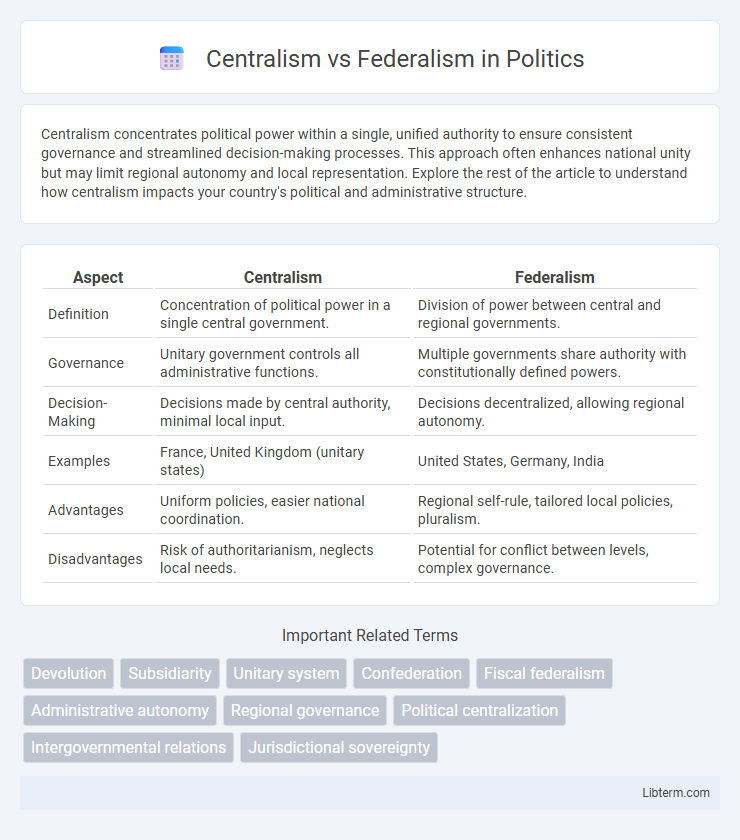Centralism concentrates political power within a single, unified authority to ensure consistent governance and streamlined decision-making processes. This approach often enhances national unity but may limit regional autonomy and local representation. Explore the rest of the article to understand how centralism impacts your country's political and administrative structure.
Table of Comparison
| Aspect | Centralism | Federalism |
|---|---|---|
| Definition | Concentration of political power in a single central government. | Division of power between central and regional governments. |
| Governance | Unitary government controls all administrative functions. | Multiple governments share authority with constitutionally defined powers. |
| Decision-Making | Decisions made by central authority, minimal local input. | Decisions decentralized, allowing regional autonomy. |
| Examples | France, United Kingdom (unitary states) | United States, Germany, India |
| Advantages | Uniform policies, easier national coordination. | Regional self-rule, tailored local policies, pluralism. |
| Disadvantages | Risk of authoritarianism, neglects local needs. | Potential for conflict between levels, complex governance. |
Understanding Centralism: Definition and Principles
Centralism is a political system where decision-making authority is concentrated within a central government, ensuring uniform policies and governance across the entire nation. Key principles of centralism include centralized control, hierarchical authority, and standardized administration, which aim to maintain national unity and consistency in law enforcement. This approach contrasts with federalism, where power is distributed among regional governments, highlighting the centralist emphasis on cohesion and centralized governance.
Exploring Federalism: Key Concepts and Characteristics
Federalism distributes power between a central government and regional entities, allowing states or provinces to exercise autonomy in specific policy areas such as education, healthcare, and law enforcement. This political structure promotes a balance of power by enabling local governments to address unique cultural, economic, and social needs while maintaining national unity. Key characteristics of federalism include constitutional division of authority, shared governance, and protection of regional identities within an overarching legal framework.
Historical Context: Origins of Centralism and Federalism
Centralism originated in the need for strong, unified control in emerging nation-states during the 17th and 18th centuries, exemplified by the French monarchy's absolute rule and the early unification efforts in Spain. Federalism emerged as a response to diverse regional identities and practical governance needs, notably in the United States Constitution of 1787, balancing power between the national government and constituent states. The historical divide reflects contrasting approaches to sovereignty, with centralism emphasizing concentrated authority and federalism promoting shared governance across multiple levels.
Centralized vs. Decentralized Governance: Pros and Cons
Centralized governance under centralism allows for uniform policy implementation and streamlined decision-making, enhancing national unity and reducing regional disparities. Decentralized governance in federalism promotes local autonomy, enabling tailored policies that address specific regional needs and encourage political participation. However, centralism can lead to bureaucratic inefficiencies and neglect of local interests, while federalism may cause policy fragmentation and coordination challenges across different levels of government.
Political Power Distribution: Central Authority vs. Regional Autonomy
Centralism concentrates political power within a single, central authority that makes uniform decisions for the entire state, ensuring consistency and control. Federalism allocates power between a national government and regional entities, granting substantial autonomy to states or provinces to legislate and govern based on local needs. This distribution in federalism creates a balance that allows regions to address specific issues while maintaining national unity.
Economic Impacts of Centralism and Federalism
Centralism often leads to uniform economic policies that can streamline taxation and public spending, potentially enhancing national infrastructure development but risking inefficiencies by ignoring regional economic disparities. Federalism promotes localized decision-making, allowing tailored economic strategies that better address regional needs and foster competition among states, which can stimulate innovation and economic diversification. However, federal structures may also result in fiscal imbalances and coordination challenges, complicating nationwide economic planning and policy consistency.
Case Studies: Centralism and Federalism Around the World
Countries like France exemplify centralism through their strong, unified national government controlling most political power, while the United States demonstrates federalism with its division of authority between federal and state governments, allowing regional autonomy. India represents a hybrid model where federalism accommodates vast diversity by granting significant powers to states, yet maintaining a robust central government to ensure unity. These case studies highlight how centralism can streamline decision-making, whereas federalism allows for tailored policies that address local needs and cultural differences.
Challenges and Conflicts in Centralized and Federal Systems
Centralism often faces challenges such as over-concentration of power leading to bureaucratic inefficiencies and marginalization of local identities, spurring conflicts over representation and resource allocation. Federal systems grapple with disputes arising from overlapping authorities, uneven development among states, and difficulties in maintaining national unity amidst diverse regional interests. Both governance models demand delicate balancing between central authority and regional autonomy to prevent political instability and ensure effective administration.
Centralism vs. Federalism: Effects on National Unity and Diversity
Centralism consolidates power within a single national government, often enhancing national unity by promoting standardized policies and reducing regional disparities. Federalism distributes authority across regional governments, fostering diversity and local autonomy while allowing varied cultural and political identities to coexist within one nation. The balance between centralism and federalism significantly influences how countries manage unity without suppressing regional diversity, impacting stability and social cohesion.
Future Trends: The Evolving Debate Between Centralism and Federalism
Future trends in the debate between centralism and federalism indicate a shift towards hybrid governance models balancing national unity with regional autonomy. Technological advancements and data-driven policymaking enhance centralized decision-making efficiency while empowering local governments through decentralized resource management. Political globalization and rising demands for local representation fuel ongoing adaptations in institutional frameworks to accommodate diverse socio-economic landscapes.
Centralism Infographic

 libterm.com
libterm.com